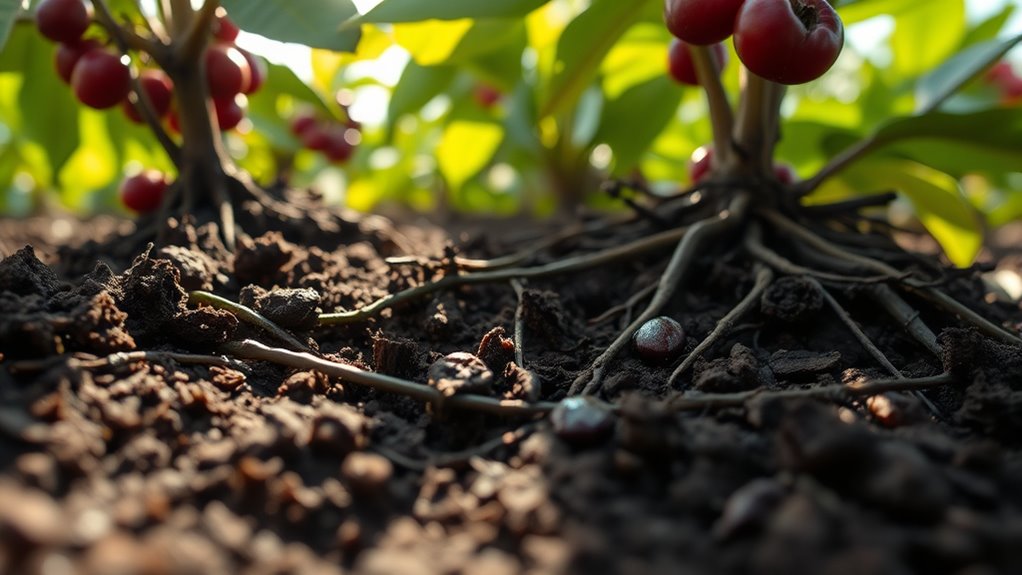Soil plays an essential role in shaping coffee flavors, influencing everything from acidity to sweetness. Nutrient-rich volcanic soils can enhance brightness, while iron-rich red soils contribute chocolate notes. The right pH levels help with nutrient absorption, impacting the overall taste of the coffee. Factors like altitude and soil management practices also affect the flavor profile. If you want to explore how specific soil types can enhance your coffee experience, there’s more insight to uncover.
Key Takeaways
- Soil composition, particularly volcanic and red soils, directly influences the complexity and richness of coffee flavors.
- Slightly acidic soil pH (5-6) optimizes nutrient absorption, enhancing the development of sugars and acids in coffee cherries.
- Nutrient-rich soils lead to improved flavor profiles, with minerals affecting the aromatic characteristics of the coffee.
- Well-drained soils with effective moisture retention are crucial for healthy coffee plant growth and flavor development.
- Soil management practices, such as organic amendments and regular testing, are essential for maintaining optimal soil health and coffee quality.
Understanding the Connection Between Soil and Coffee Flavor

When you sip your favorite cup of coffee, you mightn’t realize that the flavors you enjoy stem largely from the soil in which the coffee plants grow.
The soil composition plays an essential role in determining coffee flavors, especially when it comes to volcanic soils rich in minerals that enhance brightness and acidity. A slightly acidic pH of around 5-6 optimizes nutrient absorption, promoting the health of coffee plants and their ability to develop complex flavor profiles.
Soil composition, especially volcanic minerals, is vital for enhancing coffee’s brightness, acidity, and complex flavors.
Proper soil drainage and moisture retention are imperative; without them, you risk dull beans.
Ultimately, the interplay of soil elements shapes the sugar and acid development in coffee cherries, directly influencing the taste you savor in every cup.
Types of Soil Impacting Coffee Cultivation

The flavor of your coffee is deeply intertwined with the type of soil in which the coffee plants thrive. Volcanic soils, formed from ash and lava, are rich in nutrients like phosphorus and potassium, promoting bright, complex flavors.
In contrast, red soils, found in humid regions, are iron-rich and can create rich chocolate and caramel notes, though they require careful moisture management.
Well-drained soils with a slightly acidic pH between 4.9 and 5.6 optimize nutrient absorption, enhancing flavor profiles.
Additionally, nutrient-rich soils like Nitisols and Vertisols, prevalent in East Africa and Central America, greatly impact coffee quality.
The mineral composition of each soil type influences the aromatic characteristics, ultimately shaping the delicious cup you enjoy.
The Benefits of Volcanic Soil for Coffee
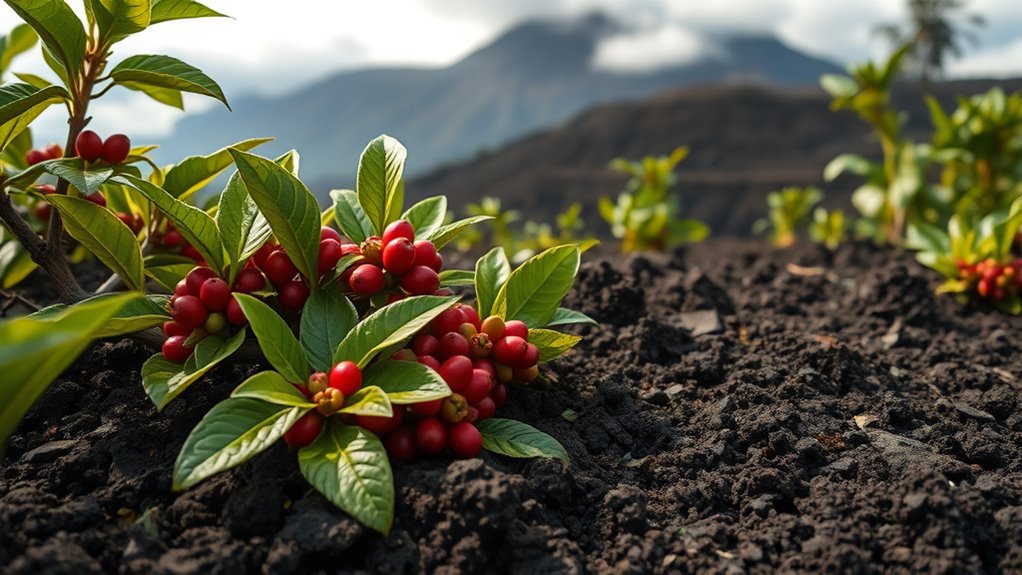
While many factors influence coffee flavor, volcanic soil stands out for its remarkable benefits. Rich in essential nutrients like phosphorus and potassium, volcanic soil promotes healthy coffee plants and enhances flavor complexity. Its fertility and well-drained nature guarantee ideal moisture retention, vital for vibrant coffee flavors. Coffee grown in these regions often showcases bright acidity and sweet fruitiness, thanks to the mineral-rich composition of the soil. High levels of minerals such as iron and magnesium contribute to unique flavor profiles, adding depth and complexity to your cup.
| Benefit | Description | Impact on Coffee |
|---|---|---|
| Nutrient-rich | Contains phosphorus and potassium | Supports plant growth |
| Well-drained | Prevents waterlogging | Enhances flavor profiles |
| High acidity | Brightens taste | Adds complexity |
| Mineral content | Includes iron and magnesium | Creates distinct flavors |
| Diverse regions | Varied growing conditions | Leads to flavor variations |
The Unique Qualities of Red Soil
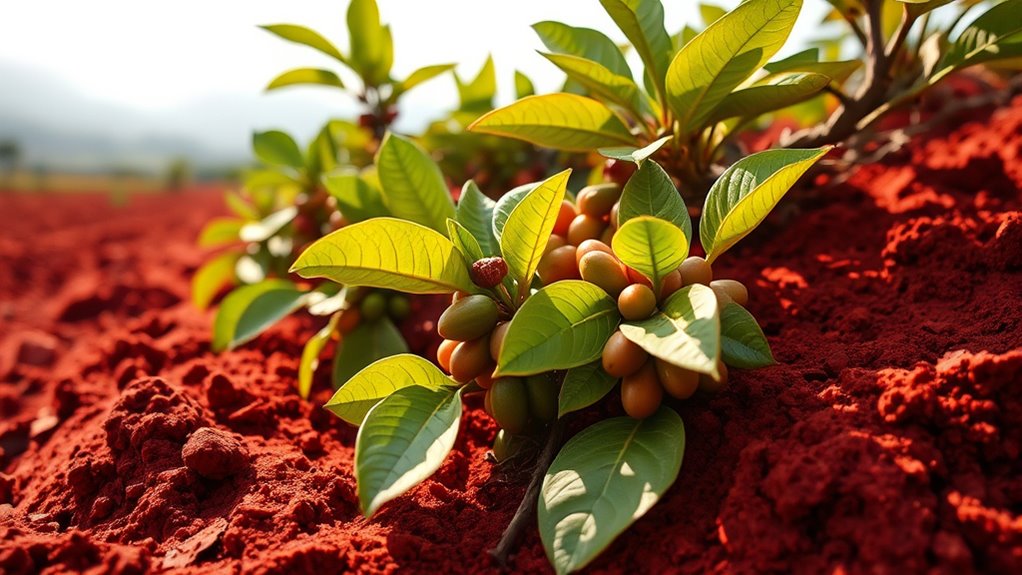
Red soil, known for its rich iron content, plays a vital role in shaping the flavor profiles of coffee. Found in humid environments, this soil type thrives at high altitudes, promoting the growth of coffee plants that yield delightful chocolate and caramel flavors.
Its unique nutrients contribute greatly to the smooth mouthfeel and full body of the beans, especially in major coffee-growing regions like parts of South America and Indonesia.
However, red soil has low water retention, making careful management essential for successful coffee farming. Extensive testing and preparation are fundamental to harness its potential, ensuring that the final taste of your coffee reflects the distinctive qualities derived from this extraordinary soil.
The Role of Clay Minerals in Soil Health

Clay minerals serve as the backbone of soil health, playing an essential role in coffee cultivation. They act like sponges, holding nutrients vital for your coffee plants. These minerals also attract water, maintaining soil moisture even during drought, ensuring your plants stay hydrated. Enhanced soil fertility from clay minerals leads to better nutrient retention and absorption of elements like potassium and magnesium, which directly influence coffee flavor. Proper management of clay content can elevate the complexity of flavors in your coffee beans by supporting aromatic compound development.
| Aspect | Benefit | Impact on Coffee |
|---|---|---|
| Nutrient retention | Holds essential nutrients | Enhances flavor |
| Moisture retention | Attracts and retains water | Supports growth |
| Soil fertility | Improves overall soil health | Boosts coffee quality |
| Clay management | Balances soil pH | Affects flavor complexity |
| Absorption efficiency | Enhances uptake of nutrients | Influences taste profile |
Exploring Nitisols and Vertisols in Coffee Production
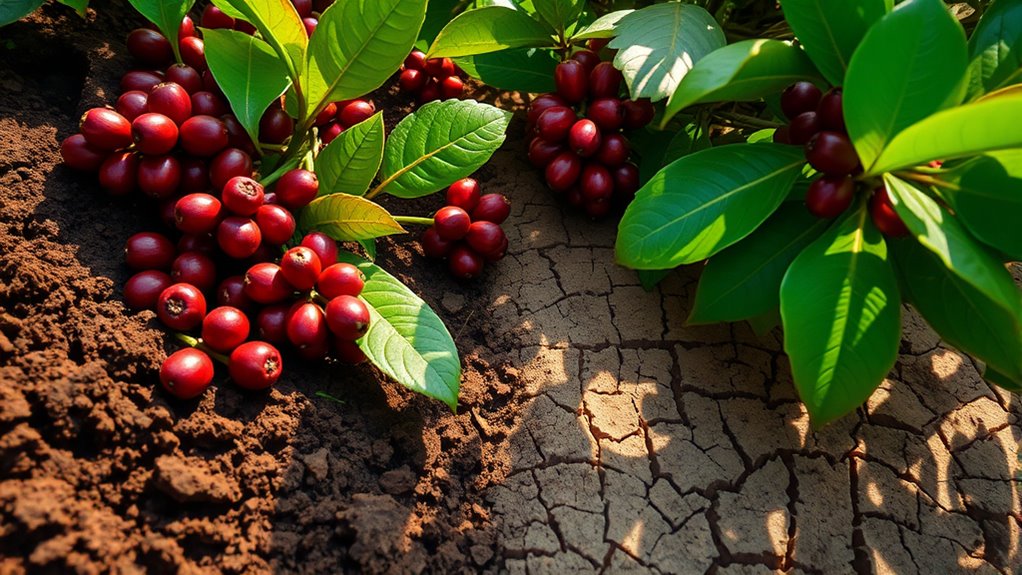
When you consider coffee production, Nitisols and Vertisols stand out for their unique benefits.
Nitisols, rich in nutrients, support strong coffee growth, while Vertisols offer excellent drainage and moisture retention.
Understanding their properties and effective soil management practices can greatly enhance the flavors of your coffee.
Nitisols: Nutrient-Rich Benefits
Nitisols stand out as some of the most nutrient-rich soils, which makes them a prime choice for coffee cultivation, especially in regions like East Africa and Central America.
These soils contain about 30% clay, ensuring excellent moisture retention, which is crucial for healthy root growth. The essential nutrients found in Nitisols markedly enhance bean development, leading to a complex flavor profile.
As a result, coffee grown in these fertile soils often yields high-quality coffee with vibrant and unique taste characteristics. By promoting ideal growth conditions, Nitisols support the cultivation of beans that aren’t only rich in flavor but also in overall quality, making them indispensable for coffee producers aiming for the best possible harvest.
Vertisols: Unique Properties Explained
While both Nitisols and Vertisols play essential roles in coffee production, Vertisols offer a unique set of characteristics that make them particularly advantageous for cultivating high-quality beans.
These nutrient-rich soils are known for their excellent drainage capabilities, crucial for effective coffee cultivation. Vertisols exhibit unique shrinking and swelling properties, allowing you to manage moisture effectively, which is critical for the health of your coffee plants.
With proper soil management, you can guarantee ideal water retention and drainage, maximizing coffee quality. The nutrient-rich composition of Vertisols enhances the flavor complexity of your coffee beans, leading to vibrant and aromatic cups.
Soil Management Practices
Understanding how to manage soils like Nitisols and Vertisols can greatly enhance your coffee production. Effective soil management practices are essential for nurturing coffee plants.
Focus on maintaining ideal soil pH and enhancing soil fertility with nutrients like nitrogen. Incorporating organic amendments, such as compost, can boost nutrient availability and improve moisture content.
Sustainable practices like crop rotation not only preserve soil health but also promote biodiversity, supporting robust plant growth.
The Science Behind Soil and Coffee Taste

Soil plays a pivotal role in shaping the flavor of your coffee, as its mineral composition directly influences the taste profile of the beans.
Here are a few key factors to contemplate:
- Minerals: Potassium, magnesium, and zinc enhance flavor complexity, while iron boosts chocolate notes and boron adds fruitiness.
- Drainage: Well-drained soil prevents waterlogging, promoting healthy plant growth and vibrant coffee flavors.
- pH Levels: Mildly acidic soils (4.9–5.6 pH) optimize nutrient absorption, enhancing the flavor profiles of your coffee.
The Importance of Sustainable Soil Management
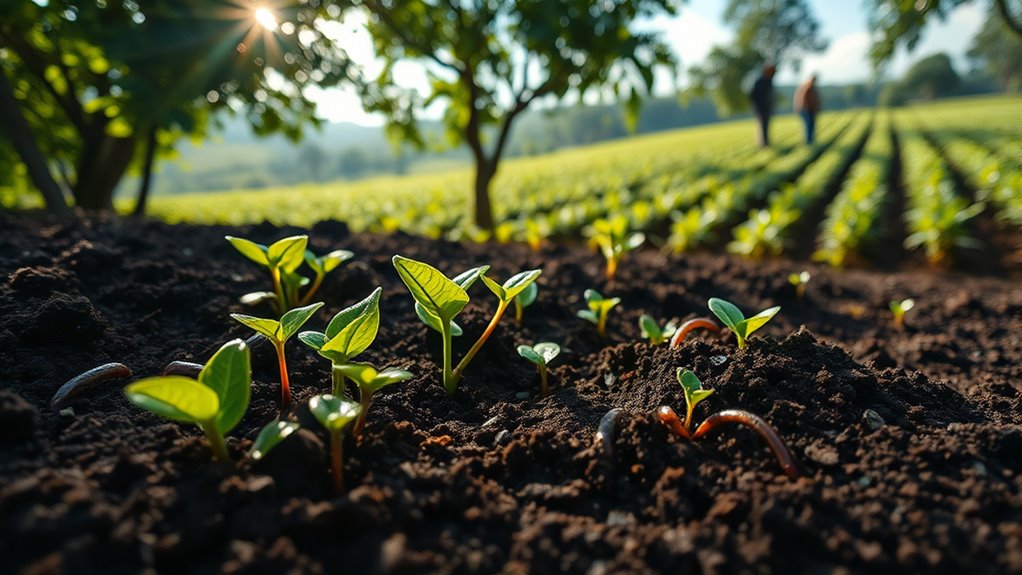
When you prioritize sustainable soil management, you’re not just caring for the earth; you’re enhancing the quality of your coffee.
Practices like organic composting and crop rotation boost nutrient levels and promote a vibrant ecosystem, which are essential for rich coffee flavors.
Soil Health Practices
While it might seem tempting to focus solely on coffee plant care, sustainable soil management is just as crucial for achieving exceptional flavor profiles. By adopting effective soil health practices, you can enhance the taste of your coffee.
- Organic composting boosts nutrient levels, promoting healthier coffee plants.
- Cover crops help prevent erosion and improve soil structure, essential for moisture retention.
- Agroforestry systems protect biodiversity and enrich soil health, leading to richer coffee flavors.
Regular soil testing can help you monitor pH and nutrient levels, ensuring the ideal conditions for coffee plants to grow.
Embracing sustainable practices like reduced tillage and minimizing chemical inputs will enhance soil microbial activity, ultimately improving the overall health of your coffee and its flavor.
Nutrient Management Strategies
To cultivate exceptional coffee, it’s essential to implement effective nutrient management strategies that promote sustainable soil practices.
By focusing on soil fertility, you can enhance coffee plant growth and improve flavor profiles. Maintaining a slightly acidic pH of 5-6 is crucial for ideal nutrient absorption, which fosters better flavor complexity in your crops.
Regular soil testing helps you identify nutrient deficiencies, allowing you to adjust fertilization practices accordingly.
Integrating organic composting and cover crops improves soil structure and prevents erosion, preserving important nutrients for coffee cultivation.
Finally, using mulching and conservation tillage retains soil moisture and nutrients, significant for flavor concentration in coffee cherries.
With these strategies, you’ll cultivate the rich, flavorful coffee you desire.
The Influence of Altitude and Environment on Flavor Profiles
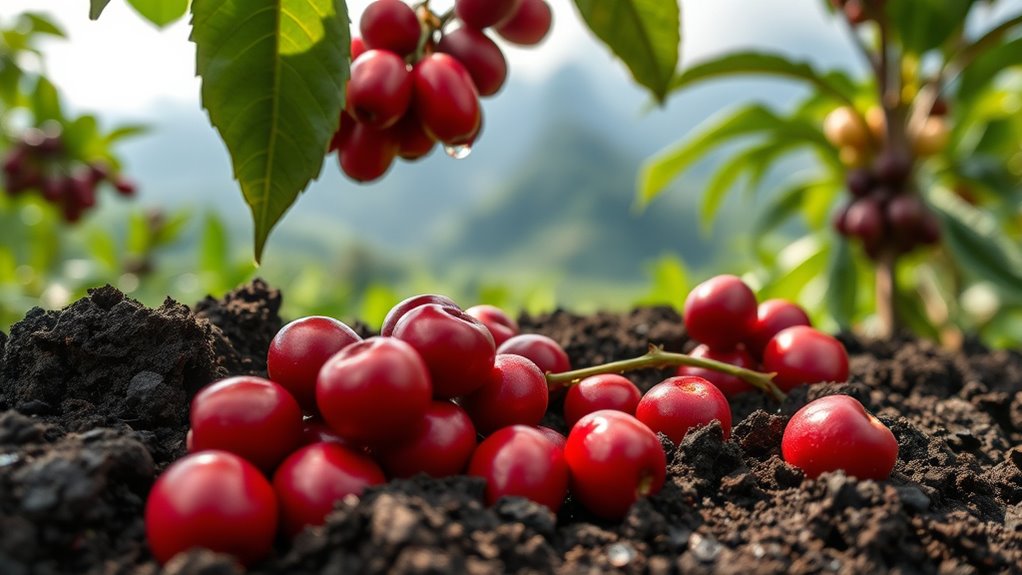
Altitude and environment play an essential role in shaping the flavor profiles of coffee. As you explore different growing areas, you’ll notice how these factors impact coffee bean quality:
Altitude and environment significantly influence coffee flavor profiles, impacting the quality of beans from various growing regions.
- Higher altitudes (1,200 masl and above) lead to richer, fruity, and floral flavors.
- Medium altitudes (910–1,200 masl) often produce sweet notes like chocolate and vanilla.
- Low altitudes (below 762 masl) may yield simpler, earthy flavors.
For coffee plants to thrive, they need ideal conditions: soil rich in nutrients, high humidity, and regular rainfall.
These environmental factors directly influence the unique taste of your brew, as the terroir affects the aromatic compounds in the beans.
Understanding these elements helps you appreciate the complexity of flavor profiles in every cup.
Frequently Asked Questions
What Happens When You Add Coffee Grounds to Soil?
When you add coffee grounds to your soil, you boost its nitrogen content, which helps your plants thrive.
The slightly acidic pH can lower soil acidity, benefiting acid-loving plants.
Coffee grounds improve soil structure by enhancing aeration and drainage, preventing waterlogging and promoting healthy roots.
They also retain moisture and support beneficial microorganisms.
If you compost them, you create a balanced fertilizer rich in essential nutrients, which further supports plant growth.
What Soil Is Good for Coffee?
Imagine sipping a cup of coffee grown in rich, volcanic soil.
You’ll find that coffee thrives best in nutrient-rich, slightly acidic soils, ideally with a pH range of 4.9 to 6. Volcanic soils are a fantastic example, renowned for their essential minerals and excellent drainage, which enhance the coffee’s brightness.
Nitisols and Vertisols also support healthy growth, providing the nutrients necessary for producing those delicious, complex flavors you love in your morning brew.
Which Soil Is Suitable for Coffee Plantation?
If you’re considering a coffee plantation, look for nutrient-rich soils like volcanic or red soils.
Volcanic soils drain well and boost flavor complexity, while red soils enhance chocolate and caramel notes, though they need careful preparation.
Aim for a soil pH between 4.9 and 5.6 to guarantee your coffee plants absorb nutrients effectively.
Also, consider using sustainable practices to maintain soil health, promoting both fertility and moisture retention for the best crop yield.
What Soil Should I Use for a Coffee Plant?
Think of your coffee plant’s soil as its cozy blanket, wrapping it in nutrients and support.
For the best growth, you should use nutrient-rich, well-draining soil with a slightly acidic pH of 5-6.
Volcanic soils are like a treasure chest of minerals, enhancing flavor.
If you’re in a humid area, red soils can work, but keep an eye on their moisture levels.
Regular testing and organic compost can keep your soil in tip-top shape!
Conclusion
In coffee cultivation, you really can’t judge a bean by its cover. The soil plays an essential role in shaping the flavors you savor in every cup. From volcanic richness to the unique properties of red soil, each type contributes distinct notes to your coffee experience. By understanding and managing soil health sustainably, you’re not just enhancing flavor; you’re also nurturing the environment. So, the next time you sip your coffee, remember: it all starts from the ground up!
